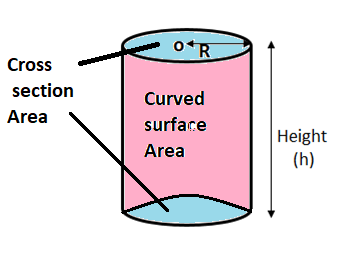
The total surface area of a cylinder is 462 ${\text{c}}{{\text{m}}^2}$and its curved surface area is $\dfrac{1}{3}$ of its total surface area. Find the radius of the cylinder (in cm).
Answer
610.2k+ views
Hint: In order to solve this problem, we must use the concept that the total surface area is the sum of curved surface area with upper and bottom cross sections areas.
Complete step-by-step answer:

The total surface area of a cylinder is 462 ${\text{c}}{{\text{m}}^2}$and its curved surface area is $\dfrac{1}{3}$ of its total surface area
So curved surface area we can find with help of given total surface area
So curved surface area = $\dfrac{1}{3}$ ×( total surface area of a cylinder)
$\therefore $ curved surface area = $\dfrac{1}{3}$ ×( 462)
On solving
$\therefore $ curved surface area = 154 ${\text{c}}{{\text{m}}^2}$ (1)
With the reference of figure,
We can say that the total surface area is a summation of the curved surface area along with the upper and bottom cross section area.
Hence we can write
Total surface area of cylinder = curved surface area + upper cross section area + bottom cross section area …… (2)
We know that
upper cross section area = bottom cross section area = $\pi {{\text{r}}^2}$
Total surface area of a cylinder is 462 ${\text{c}}{{\text{m}}^2}$ (given in question)
Put the value of curved surface area from equation (1)
So on putting all the values in result (2)
Total surface area = curved surface area + upper cross section area + bottom cross section area
⇒462 ${\text{c}}{{\text{m}}^2}$= 154 ${\text{c}}{{\text{m}}^2}$+ $\pi {{\text{r}}^2}$+ $\pi {{\text{r}}^2}$
⇒462 ${\text{c}}{{\text{m}}^2}$= 154 ${\text{c}}{{\text{m}}^2}$+ 2$\pi {{\text{r}}^2}$
⇒308 = 2$\pi {{\text{r}}^2}$
On putting $\pi = \dfrac{{22}}{7}$
⇒$2 \times \dfrac{{22}}{7} \times {{\text{r}}^2} = 308$
$ \Rightarrow {{\text{r}}^2} = \dfrac{{308 \times 7}}{{44}}$
On solving
$ \Rightarrow {{\text{r}}^2} = 49$
Taking square root on both side
$ \Rightarrow \sqrt {{{\text{r}}^2}} = \sqrt {49} $
$ \Rightarrow {\text{r}} = 7$ cm
Hence the required radius of cylinder is r=7 cm.
Note: Whenever we face such types of problems the point is to have the good gist of the diagrammatic representation using the information provided in the question as it helps understanding the geometry of the figure involved. It is always advisable to learn the direct formula for some of the basic conic sections like the cylinder as it helps and saves a lot of time.
Complete step-by-step answer:

The total surface area of a cylinder is 462 ${\text{c}}{{\text{m}}^2}$and its curved surface area is $\dfrac{1}{3}$ of its total surface area
So curved surface area we can find with help of given total surface area
So curved surface area = $\dfrac{1}{3}$ ×( total surface area of a cylinder)
$\therefore $ curved surface area = $\dfrac{1}{3}$ ×( 462)
On solving
$\therefore $ curved surface area = 154 ${\text{c}}{{\text{m}}^2}$ (1)
With the reference of figure,
We can say that the total surface area is a summation of the curved surface area along with the upper and bottom cross section area.
Hence we can write
Total surface area of cylinder = curved surface area + upper cross section area + bottom cross section area …… (2)
We know that
upper cross section area = bottom cross section area = $\pi {{\text{r}}^2}$
Total surface area of a cylinder is 462 ${\text{c}}{{\text{m}}^2}$ (given in question)
Put the value of curved surface area from equation (1)
So on putting all the values in result (2)
Total surface area = curved surface area + upper cross section area + bottom cross section area
⇒462 ${\text{c}}{{\text{m}}^2}$= 154 ${\text{c}}{{\text{m}}^2}$+ $\pi {{\text{r}}^2}$+ $\pi {{\text{r}}^2}$
⇒462 ${\text{c}}{{\text{m}}^2}$= 154 ${\text{c}}{{\text{m}}^2}$+ 2$\pi {{\text{r}}^2}$
⇒308 = 2$\pi {{\text{r}}^2}$
On putting $\pi = \dfrac{{22}}{7}$
⇒$2 \times \dfrac{{22}}{7} \times {{\text{r}}^2} = 308$
$ \Rightarrow {{\text{r}}^2} = \dfrac{{308 \times 7}}{{44}}$
On solving
$ \Rightarrow {{\text{r}}^2} = 49$
Taking square root on both side
$ \Rightarrow \sqrt {{{\text{r}}^2}} = \sqrt {49} $
$ \Rightarrow {\text{r}} = 7$ cm
Hence the required radius of cylinder is r=7 cm.
Note: Whenever we face such types of problems the point is to have the good gist of the diagrammatic representation using the information provided in the question as it helps understanding the geometry of the figure involved. It is always advisable to learn the direct formula for some of the basic conic sections like the cylinder as it helps and saves a lot of time.
Recently Updated Pages
The number of solutions in x in 02pi for which sqrt class 12 maths CBSE

Write any two methods of preparation of phenol Give class 12 chemistry CBSE

Differentiate between action potential and resting class 12 biology CBSE

Two plane mirrors arranged at right angles to each class 12 physics CBSE

Which of the following molecules is are chiral A I class 12 chemistry CBSE

Name different types of neurons and give one function class 12 biology CBSE

Trending doubts
Fill the blanks with the suitable prepositions 1 The class 9 english CBSE

Who among the following opened first school for girls class 9 social science CBSE

What does the word meridian mean A New day B Midday class 9 social science CBSE

What is the full form of pH?

Write the 6 fundamental rights of India and explain in detail

Which places in India experience sunrise first and class 9 social science CBSE




